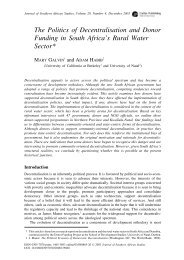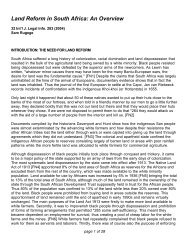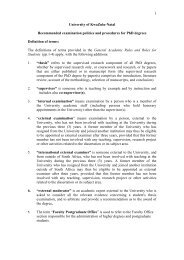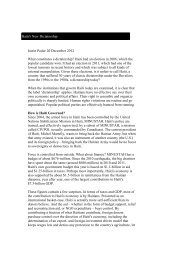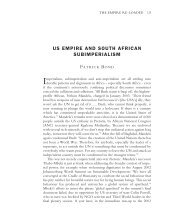Bell, Trevor : Unemployment in South Africa
Bell, Trevor : Unemployment in South Africa
Bell, Trevor : Unemployment in South Africa
You also want an ePaper? Increase the reach of your titles
YUMPU automatically turns print PDFs into web optimized ePapers that Google loves.
One consequence of this is that by 1983 the percentage unemployment rates<br />
<strong>in</strong> Canada (12.5). the Netherlandslands (12.91, the United K<strong>in</strong>gdom ( 13.5 ),<br />
Belgium (14.1) and Spa<strong>in</strong> (1 7,3) do not look nearly so low compared with<br />
<strong>South</strong> <strong>Africa</strong> (21,l <strong>in</strong> 1981) as they did <strong>in</strong> 1974, before the big upsurge <strong>in</strong><br />
OECD unemployment rates l) .<br />
Some have suggested that Simk<strong>in</strong>a' estimates suffer from a lack of cyclical<br />
sensitivity. Exam<strong>in</strong>ation of Table 2 and the graph <strong>in</strong> Figure 1, hwever,<br />
show clearly that they have been responsive to cyclical factors2).<br />
The only feature of the data which may cause some misgiv<strong>in</strong>gs on this score<br />
is the fact that there is no significant absolute decl<strong>in</strong>e <strong>in</strong> the <strong>South</strong><br />
<strong>Africa</strong>n unemployment rate dur<strong>in</strong>g the economic upsw<strong>in</strong>g from 1978 to 1981,<br />
even though there is a marked deceleration of the upward trend <strong>in</strong> 1979, a<br />
m<strong>in</strong>or absolute fall <strong>in</strong> 1980 and only a very slight <strong>in</strong>crease <strong>in</strong> 1981 to the<br />
1979 level. As we shall see belar there are good reasons for this, but <strong>in</strong><br />
any case the OECD data presented above suggest that the tendency for the<br />
unemployment rate not to fall dur<strong>in</strong>g an economic upsw<strong>in</strong>g is not someth<strong>in</strong>g<br />
peculiar to <strong>South</strong> <strong>Africa</strong>. A similar, persistent upward trend emerges <strong>in</strong><br />
the case of several other countries: Spanish unemployment rates go on<br />
<strong>in</strong>creas<strong>in</strong>g throughout the OECD boom from 1976 to 1980, as do the French,<br />
the Italian (but for a m<strong>in</strong>or decrease <strong>in</strong> 1980) and the 6elgian3),<br />
1) It is also noteworthy that the Spanish unemployment rate <strong>in</strong>creases<br />
from 2.4 per cent <strong>in</strong> 1970 to 16.6 per cent <strong>in</strong> 1982 whereas the <strong>South</strong><br />
<strong>Africa</strong>n rate rose from 16,2 per cent <strong>in</strong> 1970 to 21.1 per cent <strong>in</strong><br />
1981, so that the Spanish rate not only rose proportionately more but<br />
also by a larger number of percentage po<strong>in</strong>ts. The magnitude of the<br />
<strong>in</strong>crease <strong>in</strong> the unemployment rate <strong>in</strong> this country is therefore not<br />
out of l<strong>in</strong>e with experience elsewhere.<br />
2) Figure 1, for <strong>in</strong>stance, shows that from 1970 to 1977 the British and<br />
<strong>South</strong> <strong>Africa</strong>n unemployment rates move up and down together <strong>in</strong> more or<br />
less perfect unison, so that over this period at least the <strong>South</strong><br />
<strong>Africa</strong>n estimates are as cyclically sensitive as the British.<br />
3) In several other cases the unemployment rate does not fall <strong>in</strong> all the<br />
years of the cyclical upsw<strong>in</strong>g of the latter 1970s.




